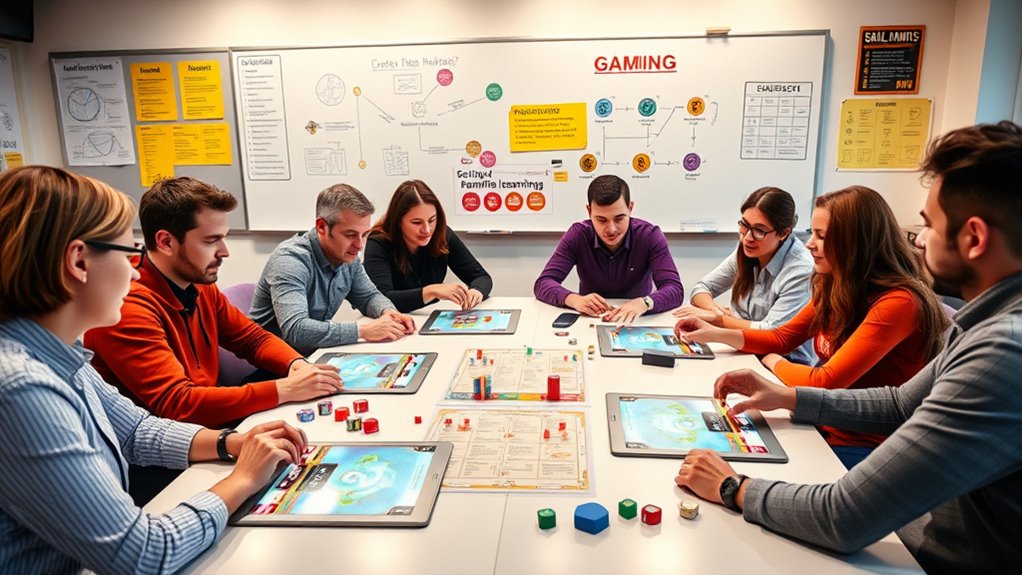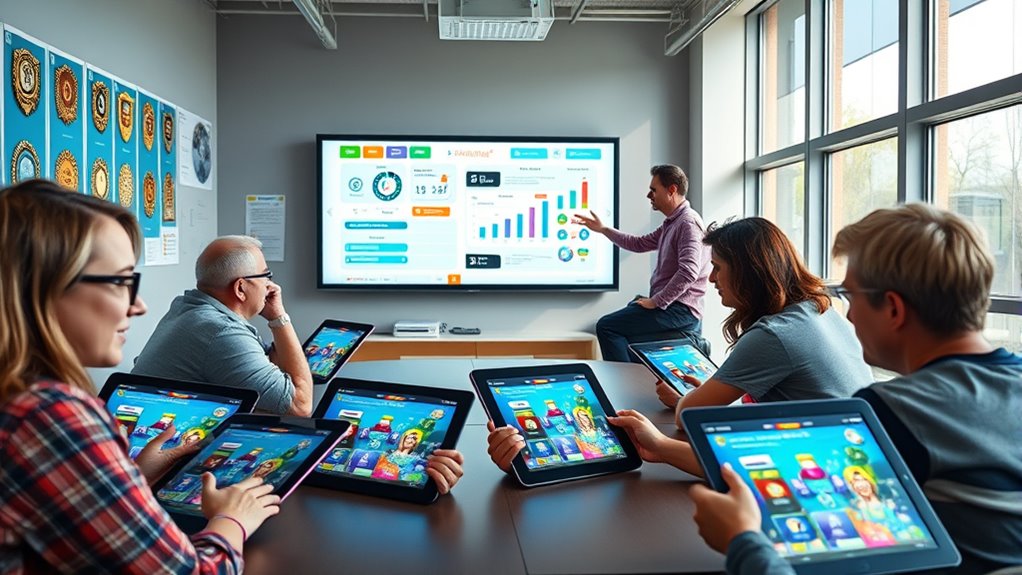To boost engagement with adult learners, incorporate gamification strategies like digital badges, leaderboards, and interactive challenges that make learning fun and motivating. Use rewards to recognize achievements and set clear goals to guide progress. Focus on fairness and inclusivity to create a positive environment. Adding elements like culturally relevant themes or community sharing can further enhance motivation. Keep exploring these techniques to release even more effective ways to energize your learners.
Key Takeaways
- Incorporate clear goals, badges, and milestones to motivate adult learners through tangible recognition of progress.
- Use leaderboards focused on personal growth and mastery to foster healthy competition without discouragement.
- Design gamification elements that emphasize fairness, transparency, and inclusivity to ensure a positive learning environment.
- Integrate culturally engaging themes, such as anime titles, to boost engagement and resonate with learners’ interests.
- Provide continuous feedback and community sharing opportunities to sustain motivation and promote social learning.

Gamification has become a powerful tool for engaging adult learners by making education more interactive and motivating. When you incorporate game-like elements into your training or coursework, you tap into intrinsic motivation, encouraging learners to participate actively rather than passively consume information. Virtual badges are one of the most effective ways to do this. These digital rewards serve as symbols of achievement, allowing learners to showcase their skills and progress in a visible, tangible way. For example, earning a virtual badge for completing a complex module or mastering a particular skill not only boosts confidence but also fuels further engagement. When learners see their accomplishments recognized, they’re more likely to stay committed and aim for more.
Leaderboards are another essential element in gamification that you can leverage to boost motivation. By displaying rankings based on points earned, badges collected, or tasks completed, leaderboards introduce a competitive edge that encourages learners to improve their performance. You might find that some learners are motivated by climbing the ranks, trying to outscore their peers, or simply seeing their name at the top. However, it’s important to design leaderboards thoughtfully. They should foster healthy competition without discouraging those who may not be performing as well. This can be achieved by customizing leaderboards to focus on personal progress over comparison with others, or by highlighting different categories of achievement, such as consistency, improvement, or collaboration.
Integrating virtual badges and leaderboards into your adult learning programs can create a sense of achievement and community. When learners see their progress reflected on a leaderboard, they’re more likely to stay engaged, especially if they’re working toward earning new badges. These badges can be linked to specific skills, milestones, or behaviors, providing clear goals to aim for. Plus, the competitive aspect can motivate learners to push themselves further, turning learning into an engaging challenge rather than a chore. As you implement these tools, remember that transparency and fairness matter. Make sure everyone understands how points are scored and badges are earned, and ensure that the competition remains positive and inclusive. Incorporating anime titles into motivational content has been shown to enhance engagement for some learners, bridging cultural interests with educational goals. Additionally, understanding the importance of Powerful persuasive words can significantly influence how you craft your gamification strategies, making them more compelling and effective. To maintain a positive learning environment, it’s also beneficial to include privacy considerations when designing gamified activities. Incorporating feedback mechanisms can further optimize learner engagement and ensure continuous improvement of your gamification approach.
Frequently Asked Questions
How Can Gamification Improve Adult Learners’ Motivation?
You can boost adult learners’ motivation by leveraging gamification, which taps into intrinsic motivation and makes learning engaging. Games encourage skill development through challenges and rewards, giving learners a sense of achievement. By incorporating elements like points, badges, and leaderboards, you create a motivating environment that fosters ongoing participation and personal growth, helping learners stay committed and enthusiastic to master new skills.
What Are Common Challenges in Implementing Gamification for Adults?
When implementing gamification for adults, you often face challenges like technology integration and cultural barriers. You might struggle to guarantee all learners have access to the necessary tools or feel comfortable using new tech. Additionally, cultural differences can make some gamification elements less effective or even off-putting. To succeed, you need to adapt your approach, address these barriers early, and foster an inclusive environment that respects diverse backgrounds.
Are There Specific Gamification Tools Suited for Adult Education?
You’ll find that digital badges and scenario-based learning are especially suited for adult education. Digital badges motivate learners by recognizing achievements, while scenario-based learning engages them with real-world applications. These tools cater to adults’ desire for relevance and tangible rewards, making your gamification efforts more effective. By integrating these strategies, you can enhance engagement, foster motivation, and support meaningful learning experiences tailored to adult learners’ needs.
How Do Gamification Strategies Differ Across Various Adult Learning Contexts?
Imagine tailoring a suit; each fabric and cut suits different occasions. Similarly, gamification strategies differ across adult learning contexts through contextual adaptation and cultural considerations. You adjust your approach based on the environment, whether a corporate training room or a community college. You incorporate relevant themes and culturally sensitive elements, ensuring engagement and effectiveness. This flexibility makes your gamification efforts resonate, fostering meaningful learning experiences for diverse adult learners.
What Metrics Measure Success in Gamified Adult Learning Programs?
You can measure success in gamified adult learning programs through engagement analytics and progress tracking. Engagement analytics show how actively learners participate, while progress tracking reveals how much they’ve advanced toward learning goals. By monitoring these metrics, you identify areas needing improvement and guarantee learners stay motivated. Success also includes increased knowledge retention and application, which you can evaluate through assessments and feedback, ensuring the program effectively boosts learning outcomes.
Conclusion
So, after all this talk about gamification boosting adult learning, you might think it’s just a game—literally. But don’t be fooled; behind the fun and rewards, real growth happens. Ironically, the key to serious learning is often just a playful twist. So go ahead, sprinkle some game elements into your lessons—you might just find that adults learn best when they’re having a little fun. Who knew?










